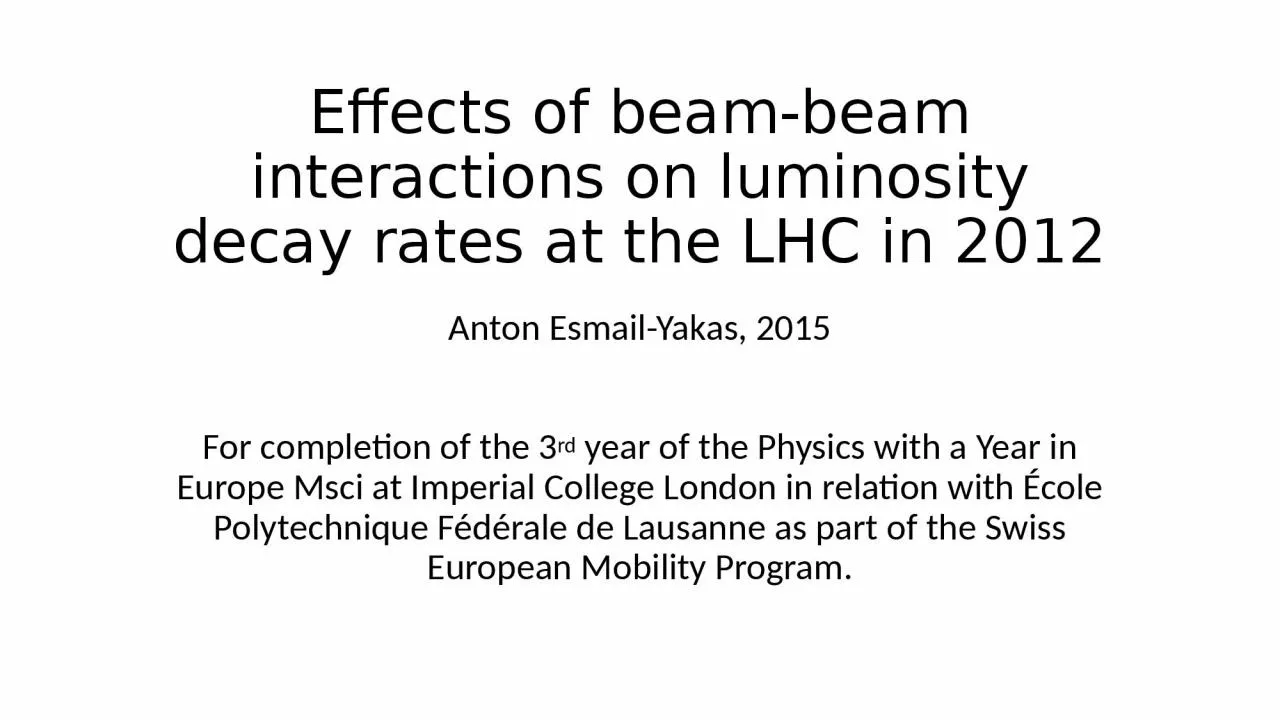

Anton EsmailYakas 2015 For completion of the 3 rd year of the Physics with a Year in Europe Msci at Imperial College London in relation with École Polytechnique Fédérale de Lausanne as part of the Swiss European Mobility Program ID: 1030061
Download Presentation The PPT/PDF document "Effects of beam-beam interactions on lum..." is the property of its rightful owner. Permission is granted to download and print the materials on this web site for personal, non-commercial use only, and to display it on your personal computer provided you do not modify the materials and that you retain all copyright notices contained in the materials. By downloading content from our website, you accept the terms of this agreement.
1. Effects of beam-beam interactions on luminosity decay rates at the LHC in 2012Anton Esmail-Yakas, 2015For completion of the 3rd year of the Physics with a Year in Europe Msci at Imperial College London in relation with École Polytechnique Fédérale de Lausanne as part of the Swiss European Mobility Program.
2. Special thanks to Xavier Buffat for help with the analysis and Danilo Banfi for help with the initial Python codes usedMain supervisor: Tatiana PieloniSupervisor from Imperial College London: Gavin DaviesSupervisor from EPFL: Leonid Rivkin
3. AimsAnalyse different available models for luminosity decayAnalyse the dependency of decay rates on BBIsAnalyse the time dependency of decay rates
4. Different fitting methodsSimple exponential modelC = 0, variable CTevatron model (“Fitting the luminosity decay in the Tevatron, E. McCrory et al., 2005)Brightness model (Xavier Buffat)
5. Simple exponential model (C = 0) + C (C variable) Constant decay rate
6. Tevatron model Theory attempts to account for IBS, beam burn-up due to luminosity, and beam-beam interactions.Time varying decay rate
7. Brightness model Assumes 2 different processes of decay – slow process () (e.g. IBS)Fast process () that is present for brightness larger than (e.g. incoherent growth due to a resonance) Two decay rates – C varying in initial hoursC = 0 in later hours
8. C = 0 fit
9. C varying fit
10. Brightness fit
11. Tevatron fit
12. Residual analysis – Whole FillC = 0 fit qualitatively worse.3 other fits produce similar results.
13. Residual analysis – 1st HourWhole fill does not model 1st hour accurately – need to fit 1st hour separatelyLittle difference between Variable C fit and other models when fitting first hour.
14. Filling scheme 2710- First half 2012
15. Decay rates pop out for bunches missing IP2s and IP8sLuminosity and Specific luminosity decay rates follow the same pattern
16. Strong and varying correlations with the LRs
17. Bunches seem to also follow HOs – only noticeable when they are missing
18. Very different pattern over whole fill compared to 1st hourSome shifts at bunches with different HOs/LRsRelated to drop in HOs?
19. Negative correlation with LRs?Or a different effect? IBS?
20. Specific luminosity decays show some relation to HOs Whole fill decay shows stronger relation to HOsrather than LRs?Likely due to stronger effect of HOs persisting throughout fill
21. Filling scheme 2998- Second half2012
22. Decay rates pop out for bunches missing IP8sLuminosity and Specific luminosity decay rates follow the similar patternVery different patterncompared to fill 2710
23. Strong and varying correlations with the LRsAlso for spec. lumi.
24. Very different pattern over whole fill compared to 1st hourDrops in decay rates for bunches with fewer total LRs
25. But no bunch by bunch correlation with LRs
26. Large change in pattern after 1st hourExpanding time window
27. Similar change in pattern
28. Equivalent analysis using 1hr sliding window – results are very different and not consistent enough to produce results for each hourModelling sections by single hours is not effective outside of the first hour
29. However, the expanding window is not necessarily better, as it only shows a different pattern for the first hour, and misses it in the following hours – e.g. hours 1-2, as seen below…
30. Decay rate vs time analysisDecay rate is calculated by an expanding window as for the bunch-bunch analysis, though expanding in 5 minute steps.Sharp drop after first hoursThough somewhat unreliable due to expanding window
31. More examples…
32. Importance of model used to fit luminosity – simple exponential (C=0) is not suitable. Models based around varying decay regimes are much betterImportance of the time period that is looked at – currently no model can fit to the whole fill and still accurately model behaviour contained within the first hour. Need to find a better model for consistent time analysisEffects in the first hours are VERY different to effects over the whole fill – Strong BBI dependencies – not yet obvious the nuances within thisStudies on a larger number of fills and relating to injection intensities of fills would be usefulClosing ideas…
33. Thank you!Questions?